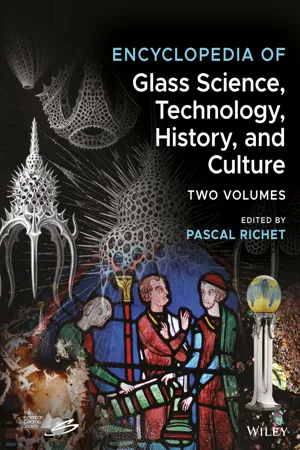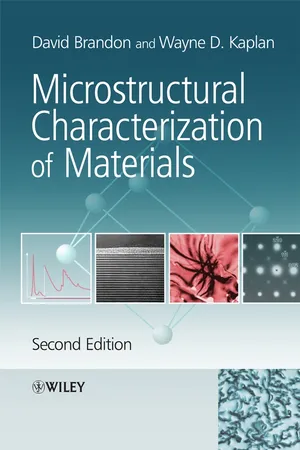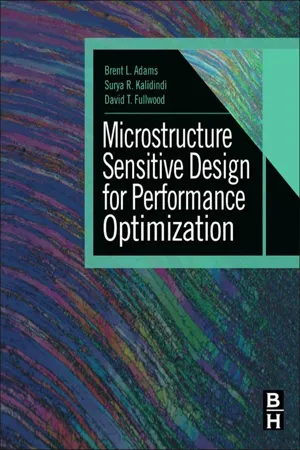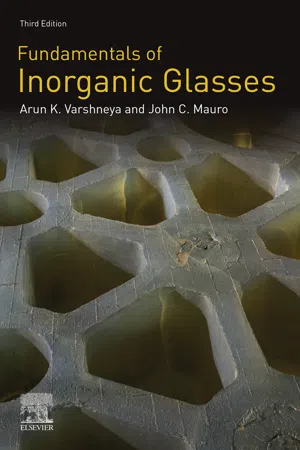Technology & Engineering
Glass Microstructure
The glass microstructure refers to the arrangement and distribution of crystalline and non-crystalline components within a piece of glass. It includes features such as grain boundaries, phase composition, and defects, which influence the material's properties and behavior. Understanding the glass microstructure is crucial for designing and manufacturing glass products with specific mechanical, thermal, and optical characteristics.
Written by Perlego with AI-assistance
Related key terms
Related key terms
1 of 4
Related key terms
1 of 3
6 Key excerpts on "Glass Microstructure"
- Pascal Richet(Author)
- 2021(Publication Date)
- Wiley-American Ceramic Society(Publisher)
2.3 Microstructure Analysis of Glasses and Glass Ceramics Christian Patzig and Thomas Höche Fraunhofer Institute for Microstructure of Materials and Systems IMWS, Halle (Saale), Germany 1 Introduction A homogeneous glass by definition lacks a microstructure at a scale larger than a few nanometers. As soon as actual inhomogeneities occur, in contrast, a detailed picture of their size, distribution, composition, and spatial arrangement becomes important to understand the properties of the material. In turn, the improved capabilities of microstructural studies in terms of spatial and elemental resolution are becoming increasingly important to optimize crystallization or phase separation and to achieve the desired microstructure and associated properties (Chapter 7.11). As a matter of fact, the beauty and challenge of glasses and glass ceramics is their diversity and complexity. The purpose of this chapter thus is to review the main microstructural methods commonly used to study inhomogeneous glass‐based materials. In preamble, however, it is important to note that studying extremely small volumes in great detail can result in “knowing everything about nothing.” In other words, it is critically important to make sure that the information gathered locally is actually representative for larger volumes. To achieve this goal, highly resolved information must be combined with additional integral measurements to get a broad picture. In addition, artifacts introduced upon either preparation or investigation of the sample must be avoided. And one should also be extremely careful with in situ microstructural experiments where, because of dramatic differences in the surface‐to‐volume ratio, annealing can easily lead to results not observed in the bulk- eBook - ePub
- David Brandon, Wayne D. Kaplan(Authors)
- 2013(Publication Date)
- Wiley(Publisher)
1
The Concept of Microstructure
This text provides a basic introduction to the most commonly used methods of microstructural characterization. It is intended for students of science and engineering whose course requirements (or curiosity) lead them to explore beyond the accepted causal connection between the engineering properties of materials and their microstructural features, and prompt them to ask how the microstructures of diverse materials are characterized in the laboratory.Most introductory textbooks for materials science and engineering emphasize that the processing route used to manufacture a component (shaping processes, thermal treatment, mechanical working, etc.) effectively determines the microstructural features (Figure 1.1 ). They note the interrelation between the microstructure and the chemical, physical, and/or mechanical properties of materials, developing expressions for the dependence of these properties on such microstructural concepts as grain size or precipitate volume fraction . What they do not usually do is to give details of either the methods used to identify microstructural features, or the analysis required to convert a microstructural observation into a parameter with some useful engineering significance.This book covers three aspects of microstructural characterization (Table 1.1 ). First, the different crystallographic phases which are present in the sample are identified. Secondly, the morphology of these phases (their size, shape and spatial distribution) are characterized. Finally, the local chemical composition and variations in chemical composition are determined.In all three cases we will explore the characterization of the microstructure at both the qualitative and the quantitative level. Thus, in terms of crystallography, we will be concerned not only with qualitative phase identification, but also with the elementary aspects of applied crystallography used to determine crystal structure, as well as with the quantitative determination of the volume fraction of each phase. As for the microstructure, we will introduce stereological relationships - Brent L. Adams, Surya R. Kalidindi, David T. Fullwood(Authors)
- 2012(Publication Date)
- Butterworth-Heinemann(Publisher)
Chapter 4
Description of the Microstructure
Chapter Outline
4.1 Local States and Local State Space 4.1.1 Multiphase composites 4.1.2 Polycrystalline microstructures 4.1.3 Multiphase polycrystals 4.2 Measure of Local State Space 4.3 Local State Distribution Functions 4.3.1 Grain size distribution function 4.3.2 Grain boundary inclination distribution function 4.3.3 Orientation distribution function 4.3.4 Grain size and ODF-combined distribution function 4.4 Definition of the Microstructure Function 4.4.1 The microstructure ensemble 4.4.2 Other distribution functions from the microstructure function SummaryIn the previous two chapters we reviewed general mathematical concepts and tools that will be used in a microstructure-design framework. In this chapter we take our first look inside real materials by considering how structure is defined in composite and polycrystalline materials. Of particular importance will be the orientation distribution function, which will be combined with spectral methods in Chapter 5 to form our most commonly used structure descriptor for the rest of the book.The word “microstructure” refers to the myriad features of the internal structure of heterogeneous materials at a variety of length scales. At coarse-length scales it is common for microscopes to reveal a material partitioned into regions of nearly continuous phase or properties, such as grains, fibers, or precipitates. Deeper inquiry reveals the atomic structure of these constituents, including lattice constants and lattice orientation of the crystalline components that are found in many natural and engineered materials.Still deeper inquiry leads to the study of defects in the atomic structure of constituent phases, including the state of vacancy and interstitial concentrations, the presence of fine-scale precipitates, voids, grain boundaries, and the state of dislocation in the material. Beyond the atomic structure of the material lies the realm of electronic and nuclear states of the atoms and their aggregates. All of these features of the internal structure impact the properties and the performance of the material.- eBook - ePub
- Arun K. Varshneya, John C. Mauro(Authors)
- 2019(Publication Date)
- Elsevier(Publisher)
Chapter 4Glass Microstructure: Phase separation and liquid immiscibility
Abstract
Glass often appears homogeneous. There is evidence, however, that the microstructure of many glasses, on the scale of a few hundred atoms, is not as homogeneous as that of a perfect single crystal or a liquid solution. In the preceding chapter, we noted two processes leading to the development of inhomogeneous microstructure in glass. One of these was the crystallization or devitrification where definite crystalline forms nucleate and grow from a supercooled liquid mass. Here we discuss liquid-liquid phase separation in glass, including both droplet nucleation and spinodal decomposition.Keywords
Glass; Thermodynamics; Phase separationGlass often appears homogeneous. There is evidence, however, that the microstructure of many glasses, on the scale of a few hundred atoms, is not as homogeneous as that of a perfect single crystal or a liquid solution. In the preceding chapter, we noted two processes leading to the development of inhomogeneous microstructure in glass. One of these was the crystallization or devitrification where definite crystalline forms nucleate and grow from a supercooled liquid mass. To cause a molten liquid mass to devitrify, the mass needs to be heat-treated below the liquidus and above the glass transition. By cooling sufficiently rapidly through this range of temperatures to below T g , the liquid is frozen into a noncrystalline solid-like state, which is called glass. The second type of microstructural inhomogeneity was discussed in context with the Lebedev crystallite theory. The crystallites were not microcrystals; they possessed distorted lattices but did have definite chemical compositions determined by the phase equilibrium diagram applicable to the system. (Recall that a phase is a homogeneous region across which the properties are uniformly constant and is bounded by a surface having a distinct surface energy. As long as the distorted crystalline lattices are “homogeneous” and are connected to the rest of the noncrystalline structure through an identifiable boundary, they qualify for being called a separate phase.) We also note that not all glasses are multi-phased. Some, notably fused silica, clearly lack microstructure even on a sub-nanometer scale. In essence, real glasses appear to span a continuous range of nanostructures and microstructures; Zachariasen's continuous random network being one extreme and the inhomogeneous microstructure such as Lebedev's crystallite view, as well as “spinodal” microstructures (to be discussed later in this chapter), being the other extreme. This picture of continuous morphology as an inhomogeneous structure, falling under the topic called phase separation - eBook - ePub
- Hani M. Tawancy, Anwar Ul-Hamid, Nureddin M. Abbas(Authors)
- 2004(Publication Date)
- CRC Press(Publisher)
Light optical microscopy is an extremely useful technique for characterizing the overall or gross microstructural features of a material such as grain structure (grain size, shape, and orientation). A typical light optical microscope consists of (i) light source, (ii) specimen stage, (iii) a glass objective lens, (iv) glass magnifying lenses, (v) viewing screen, and (vi) an image recording system. In this technique, the microstructure is revealed by reflection of light radiation from the surface of a bulk specimen.Figure 8.1A schematic illustrating the basic function of a microscope.aFigure 8.2Various techniques for microstructural characterization, classified according to the type of radiation used to illuminate the object.Specimens for examination by light optical microscopy are prepared in three successive stages: (i) grinding, (ii) polishing, and (iii) etching. First, the surface of the specimen is ground with successively finer grits of silicon nitride starting with 80 grit followed by 180, 320, and finally 600 grit. Second, the surface is intermediately polished using a 6 and 1 µm diamond paste. Final polishing is carried out using a suspended solution of 0.05 µm gamma-alumina. A proper etchant (chemical reagent) is then applied to the surface to outline the gross microstructural features.Figure 8.3Comparative useful resolving ranges of various techniques for microstructural characterization.Etching is essentially a chemical reaction between the material of the specimen and the etchant resulting in dissolution of the material. However, depending upon the etchant used, this dissolution does not occur uniformly over the entire surface. Since atoms at grain boundaries are in a higher energy state than atoms within the grains, preferential etching or dissolution can occur at grain boundaries, making them appear as shallow steps at the surface of the specimen. Also, it is possible that the rate of dissolution varies with the orientation of the grains and their compositions. - eBook - ePub
- Mic Patterson(Author)
- 2011(Publication Date)
- Wiley(Publisher)
Chapter 6 Glass as a Structural Material Glass is being used increasingly as a structural material (Figure 6-1). Even before the discovery of heat-treating glass to enhance its strength, the nineteenth-century conservatory designers and builders were using glass as a stressed skin to stabilize the iron structures supporting it. Glass is an exceptionally strong material, but its extreme brittleness presents distinct challenges in structural applications. Figure 6-1 : Apple Store, Fifth Avenue, New York City, 2006, Bohlin Cywinski Jackson architect with Eckersley O’Callaghan as the glass engineer. The Apple Cube broke new ground in glass structure design. There are many aspects to the use of glass as a structural material, as well as books dealing exclusively with the subject. 1 In using glass as a structural material, it is necessary to understand the processes and techniques used to enhance the performance of glass as a load-bearing material. These are the fundamentals from which sound structural applications derive. Once the structural components of glass have been devised, the next challenge becomes connecting them to each other and to other structural elements. The recently completed TKTS project at Times Square in New York City (see Chapter 17) affords an opportunity to see how the connections were handled in a heavily loaded glass structure. Heat-treating Heat-treating refers to the postprocessing of float glass to improve its strength and/or to alter its breakage behavior. Glass is annealed as part of the float glass process, and annealing itself is a form of heat treatment. Heat-treating, or toughening as it is referred to in Europe, is a process developed by the French in 1928. It provided the material properties necessary for the structural glass systems to follow decades later. Point-fixed glass systems utilize heat-treated glass. There are two kinds of heat treatment, heat-strengthened and fully tempered (partially toughened and fully toughened)
Index pages curate the most relevant extracts from our library of academic textbooks. They’ve been created using an in-house natural language model (NLM), each adding context and meaning to key research topics.
Explore more topic indexes
Explore more topic indexes
1 of 6
Explore more topic indexes
1 of 4





